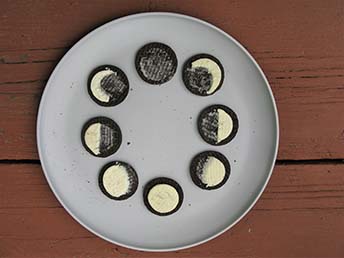Last updated: August 14, 2020
Lesson Plan
Moon Phases With Cookies

- Grade Level:
- Lower Elementary: Pre-Kindergarten through Second Grade
- Subject:
- Science
- Lesson Duration:
- 30 Minutes
Essential Question
How does the moon change and why does the moon look different every night?
Objective
Students use the frosting of Oreo cookies to visualize the phases of the moon using the contrast of the frosting and cookie to represent light and shadows on the surface of the moon as seen from Earth.
Background
The moon fully orbits around Earth about once every month. During its orbit, we can see the moon in different phases. The phases are controlled by the amount of sunlight reflected off the moon that we can see from Earth at any point during its orbit.
You Will Need:
- 8 Oreo Cookies
- A popsicle stick or other tool for scraping the frosting
- Slowly twist an Oreo open to leave as much frosting on one side of the cookie as possible. If it doesn’t work, eat the cookie and try again!
- Use the popsicle stick or scraper to create the phases of the moon out of the frosting.
- Arrange the phases of the moon in order.
Preparation
This activity is most successful when students understand the movement of the moon around the Earth and have some background on the different phases of the moon
Materials
Download Printable - Cookie Moon Phases
Procedure
- Prepare materials for your class. This activity is most successful when students can work alone or in pairs. Each student or pair will need 8 cookies and one scraper (per person)
- Prompt students to think about each kind of moon they have seen (full moon, half moon, crescent moon, new moon, gibbous moon)
- As the students come up with their responses, have them scrape the frosting off of the cookies to create the different phases of the moon
- Once they have created each phase, have students arrange their cookies in order. Since the phases occur in cycles, it is a good idea to have them arrange the pattern in a circle.
- For an optional addition: add an object to represent Earth in the middle of the phase circle and a sun on the outside of the circle to identify the light source.
Additional Resources
This model is a great visual representation of a simple cycle of the phases of the moon. To better visualize the phases of the moon, you may place an object in the center of the moon phase circle and place another object on the outside of the moon phase circle to represent the sun.
https://spaceplace.nasa.gov/oreo-moon/en/
https://sciencebob.com/oreo-cookie-moon-phases/
Contact Information
Email us about this lesson plan
